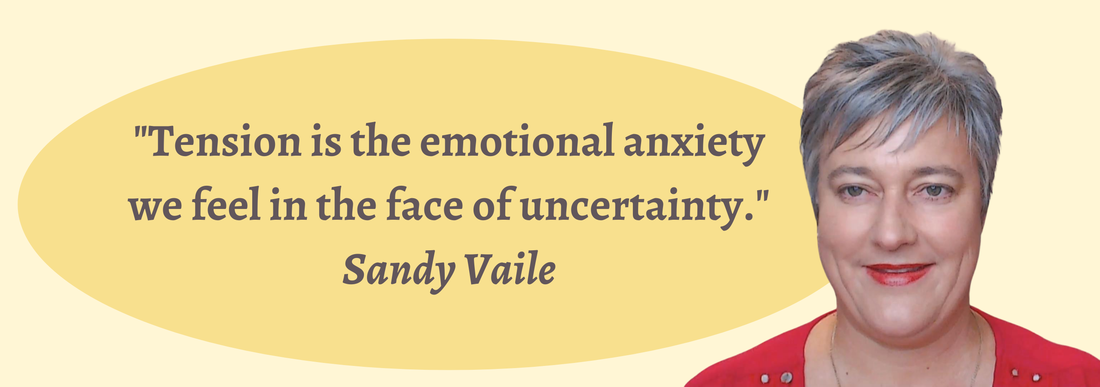|
Author: Sandy Vaile Originally published on the Romance Writers of Australia blog 08/06/20. The importance of matching suspense to the fluctuations of plotTension is a critical element of all stories and needs to be maintained in order to keep readers turning the pages, but how does this correspond to the fluctuations of plot? There can’t be life-threatening situations in every chapter, nor are all stories about mortal danger. So, let’s explore how you can match the fluctuations in a story’s plot to the level of tension. First we need to be on the same page in understanding what tension and plot fluctuations are, and then we’ll explore how to synchronise the two for jaw-clenching read. What is tension?In fiction we focus on the emotional strain caused by unpleasant things that might happen to characters, especially to the protagonist (hero/heroine). To create tension we develop characters our readers care about (or are at least interested in), give them something important to lose and then put all sorts of obstacles in their way to make the outcome of their journey uncertain. All of this makes the reader worry. What are plot fluctuations?The events that comprise the plot of a story DO NOT happen along a straight line. Over a whole story there is a pattern of rising tension that culminates in a crisis, and then falling tension as the characters consider their next move and gather resources. This pattern is repeated over and over again. You may have heard these fluctuations called many things, like scene and sequel, action and reaction, or conflict and reflection. Even within chapters there may be places where tension is high or low, but it will still be there. If there is no tension at all, the story has either concluded or the reader has dozed off.” Think of tension as the thread that connects all of your plot parts together. It is stiched through the internal and external conflicts, key plot points, character transformation, uncertainty of each situation and the unresolved questions you’ve raised, holding everything together and coaxing the reader along for the ride. So, how can you recognise and then treat the different degrees of tension? Degrees of tensionTension can be intensified and relaxed but never totally released. We want readers to keep turning pages, not be totally out of breath as though they’ve run a marathon, and the way to do that is by increasing and decreasing tension levels. Just as the action and conflict in a story plot rises and falls, so too are their corresponding rises and falls in tension. It gradually builds as the story reaches a climactic moment, i.e. where major revelations/battles/events occur, and then relaxes during moments of reflection or preparation for the next situation. Blatant tensionIncrease tension during times of turmoil, like mortal danger, a life upheaval or imminent threat to something the character cares about. When you reach key moments (plot points) in your story, tension should be high, with the reader desperate to know what happens next and truly worried for the stability/happiness/safety of the protagonist. In order to do this, we can use techniques like dropping shocking revelations, increasing what’s at stake for the characters, creating a sense of urgency for an outcome like giving them a deadline or forcing the protagonist to face something she dreads. Examples of blatant tension:
Subtle tensionDecrease tension when your characters need time to reflect on what just happened, solve a conundrum or gather themselves for the next onslaught. These moments allow the reader to breathe a little and fall in love with your characters. They happen in between crises and are particularly important in romance stories because readers expect to spend time exploring the character’s emotions and inner turmoil. Even in thriller stories there will be times when characters need to gather intel, collect resources or move to a different location. But even when you decrease the level of tension, the uncertainty about the outcome of the whole situation doesn’t completely ease. To achieve subtle tension we use techniques like raising questions, planting hooks, changing expectations, hint at a character’s fears or secrets and foreshadowing the turmoil to come. Subtext is an excellent way to cast uncertainty on what a character is actually saying or doing. Examples of subtle tension:
 Think of the pace of tension like the surge and retreat of waves at the beach. It builds to a crest, crashes dramatically and then quietly fades back to the ocean, over and over again. Match each wave with key moments in your story plot so you can control the increase and decrease of anxiety your reader experiences, but never let it completely disappear. Don't miss out on future articles, tips and writing resources from Sandy Vaile. Subscribe and grab a copy of the "Distancing Words to Avoid" guide.
0 Comments
Your comment will be posted after it is approved.
Leave a Reply. |
Fearless ProseEmpowering aspiring authors to confidently write novels they're proud to publish Categories
All
Archives
May 2024
|
© Sandy Vaile 2012-2024 |
Contact and Privacy Policy - About Sandy |




 RSS Feed
RSS Feed